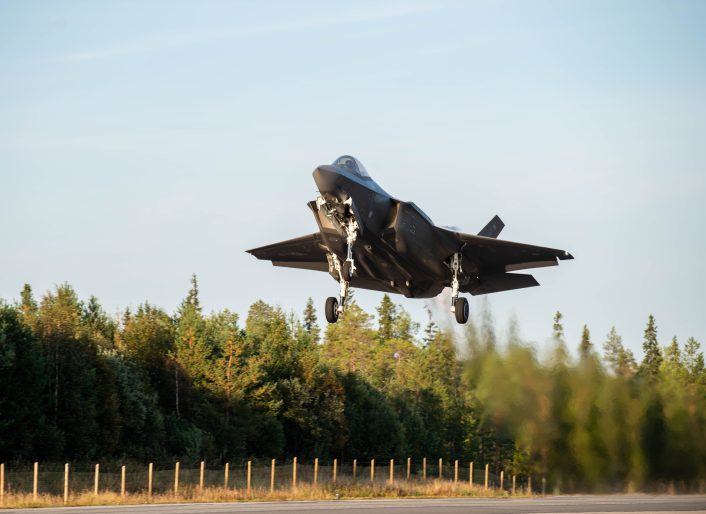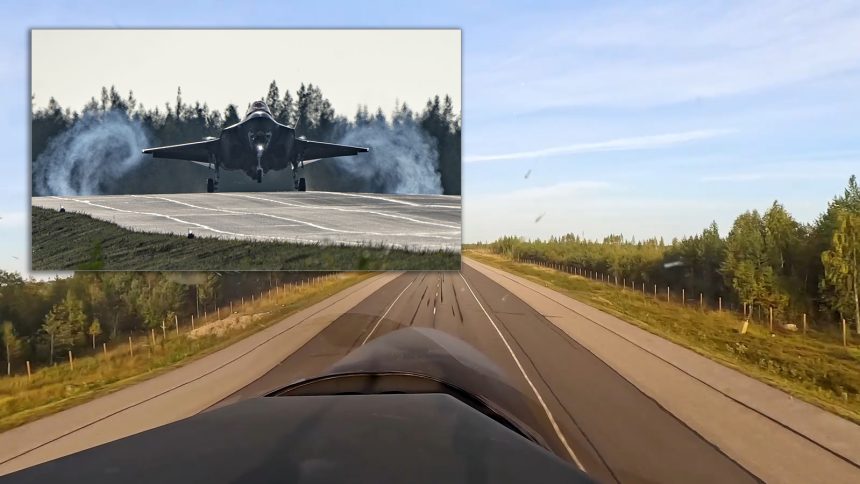A newly released cockpit video gives a first-person view of the U.S. F-35s as they operated from a highway strip during the Baana24 exercise in Finland last month.
A new cockpit video offers an exclusive look at the operations carried out during Exercise Baana 24, in which two U.S. Air Force F-35As landed for the first time on a highway in Finland. The historic event, which took place on Sept. 4, 2024, saw the 495th Fighter Squadron’s Lightning II fighters operate from the makeshift airstrip in Hosio, Ranua, Finland.
The video, released on the DVIDS network a month after the exercise, offers a unique perspective on the challenges and precision required to execute a landing on an unconventional surface like a highway. From approach maneuvers to speed management and interaction with the ground support team, the footage provides an insight into what it takes to execute a safe and efficient landing in an unconventional environment.
The B-Roll footage, captured through a camera installed on the glare shield in the cockpit, includes two landing clips and two take-off clips, collected by both the aircraft. An aspect which immediately gets the eye is the reduced space available, with the narrow highway strip and the even narrower “taxiway”, the latter just slightly larger than the main landing gear’s track width.
The video starts with the first aircraft on approach, showing how after the landing it is marshalled to the end of the strip for a hot brakes check and then, bouncing from a marshal to the other like on an aircraft carrier, to the designed refueling area where a fuel truck and personnel air waiting. In both videos it’s possible to see the German Eurofighters parked on the side of the highway strip as the F-35s come in to land, with the second Lightning also performing a touch and go.
The video then continues showing both aircraft as they depart again from the highway strip in the opposite direction. In fact, since a highway strip doesn’t have the “luxury” of a taxiway alongside the entire length of the runway like in a standard airport, the aircraft is usually turned around at the end of the runway after landing and then takes off again in the opposite direction.
The Baana 24 exercise
Baana, known in NATO as “Imminent Field,” is the Finnish Air Force’s annual exercise focused on road base operations. According to the Finnish Air Force, the exercise is part of Finland’s strategy to maintain readiness by dispersing aircraft across various locations outside main bases, enhancing operational flexibility.
During Baana 24, flight operations were conducted from Sept. 2 to 5, with a backup day on September 6. Activities included take-offs and landings on highway strips by F/A-18 Hornets, Hawk trainers, and support aircraft, with participation from U.S. and German forces.
The landing of the two F-35s of the Valkyries on Sept. 4 marked the first time in history a U.S. fighter aircraft operated on a Finnish highway strip. During the exercise U.S. Air Force Airmen expanded on Agile Combat Employment capabilities by learning austere environment aircraft landing and take-off operations and techniques from their Finnish counterparts.
The U.S. F-35A participation in the Finnish Baana 24 drills comes approximately one year after two F-35As of the RNoAF (Royal Norwegian Air Force) operated out of a road strip in Finland for the first time: on Sept. 21, 2023, the two Lightning II aircraft landed on a road near Tervo, in the province of Eastern Finland, as part of the Baana23 dispersed operations exercise. The landing on the Finnish motorway by the RNoAF F-35As last year marked the first time a CTOL (Conventional Take Off and Landing) variant of the Lightning II carried out highway operations.

Highway operations and Agile Combat Employment
After World War II and throughout the Cold War, several countries, particularly in Eastern Europe, adopted the concept of highway strips—designated sections of highways or public roads that could be used as runways. This approach aimed to address the vulnerability of airbases, whose locations were well-known and would likely be targeted early in any conflict.
In the last decade, there has been a resurgence in training for dispersed operations, including highway landings, as seen with Finnish, Swedish, Swiss and U.S. drills. More recently, the war in Ukraine has shown how airfields, even those located quite far from the battlefront, can be vulnerable to attacks conducted with drones.
In fact, the war in Ukraine further highlighted the need to reinforce the ability to perform Agile Combat Employment (ACE) operations. The U.S. Air Force introduced this concept well before the start of the war in 2022, as part of its own adaptation of the Dynamic Force Employment (DFE) used by the U.S. military as a whole.
DFE is the new strategy that combines strategic unpredictability with operational adaptability, first introduced by the 2018 National Defense Strategy. The key concept is to be operationally unpredictable in order to disrupt an adversary’s ability to respond and target allied forces.
In its press releases, the Air Force mentioned in the past that DFE operations fall under the ACE capabilities which allow to “improve passive and active defense capabilities to ensure a competitive advantage and to protect assets and personnel in the future.” Specifically, the Agile Combat Employment has been defined by the Air Force in its doctrine as “a proactive and reactive operational scheme of maneuver executed within threat timelines to increase resiliency and survivability while generating combat power.”
ACE essentially involves operating from austere airfields, large roads and highways with little supporting and technical infrastructure, dispersing assets out from the larger air bases that are likely to come under a sudden volume of Russian or Chinese tactical ballistic and cruise missiles. The strategy, while complicating adversary planning, also allows to hold adversary targets at risk from multiple locations.
The renewed interest in dispersed operations, including highway operations, testifies to the evolution of military strategies in response to contemporary threats in the current volatile geopolitical environment. The advent of technologies such as drones and ballistic and cruise missiles, as seen in current conflicts, has made traditional air bases more vulnerable, necessitating the search for more flexible and resilient alternatives.
The ACE concept, which could be considered as a modern take on the similar Cold War tactic, contributes to improving the survivability, responsiveness, and combat power of air forces in contested environments. The war in Ukraine has further highlighted the relevance of this concepts, demonstrating the need to adapt military doctrines and infrastructures to the changing dynamics of the battlefield.









